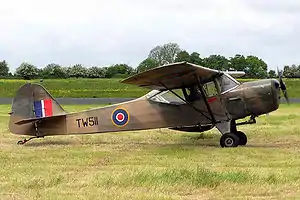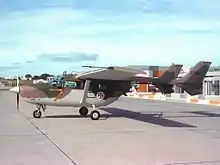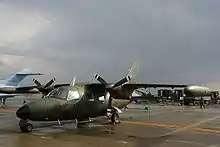Liaison aircraft
A liaison aircraft (also called an army cooperation aircraft) is a small, usually unarmed aircraft primarily used by military forces for artillery observation or transporting commanders and messages. The concept developed before World War II and included also battlefield reconnaissance, air ambulance, column control, light cargo delivery and similar duties. Able to operate from small, unimproved fields under primitive conditions, with STOL capabilities, most liaison aircraft were developed from, or were later used as general aviation aircraft. Both fixed-wing aircraft and helicopters can perform liaison duties.

Taylorcraft Auster 5 liaison aircraft of 1957
Use by Country
Bulgaria
Japan
Imperial period:
- Kokusai Ki-76 (Imperial Japanese Army Air Force, 1942-1945)
- Tachikawa Ki-36 (Imperial Japanese Army Air Force, 1938-1945)
Postwar period:
- LR-1 (Japan Ground Self-Defense Force, 1967-2016)
- LC-90 (Japan Maritime Self Defense Force, 1974-)
Poland
Portugal

Former Reims-Cessna FTB-337 of the Portuguese Air Force
- Piper L-21 Super Cub (Portuguese Army, 1952-1957 and Portuguese Air Force, 1957-1976)
- Auster D.5/160 (Portuguese Air Force, 1961-1974)
- Dornier Do 27 (Portuguese Air Force, 1961-1979)
- Reims-Cessna FTB-337, (Portuguese Air Force, 1974-2007)
Soviet Union
- Polikarpov Po-2 Kukuruznik ("Crop Duster")
Sweden
- Piper PA-18-150 Super Cub as Flygplan 51, 1958-1974
- Dornier Do 27 as Flygplan 53, 1962–1991
- Scottish Aviation Bulldog as Flygplan 61C, 1972–1989
Switzerland
United Kingdom
United States

Vultee L-1A
- Vultee L-1 Vigilant
- Taylorcraft L-2 Grasshopper
- Waco S Series Waco C-72 or AAF UC-72 series
- Beechcraft Model 17 Staggerwing AAF Beech UC/YC-43 Traveler (Navy GB-1/2)
- Aeronca L-3 Grasshopper
- Piper L-4 Grasshopper
- Stinson L-5 Sentinel
- Interstate L-6 Cadet
- North American / Ryan L-17 Navion
- Cessna O-1 Bird Dog
External links
See also
References
This article is issued from Wikipedia. The text is licensed under Creative Commons - Attribution - Sharealike. Additional terms may apply for the media files.

_landing_at_Naval_Air_Facility_Atsugi.jpg.webp)
